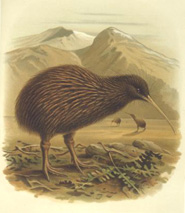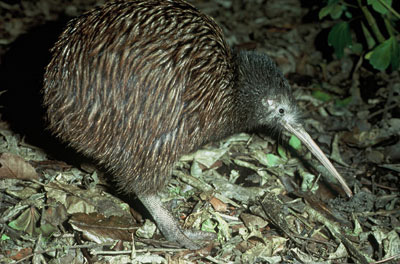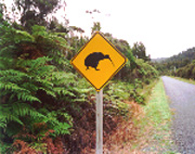Kiwi decline
99% loss in the last 100 years
Before humans arrived in the 13th century there were about 70 million
kiwi. In 1900 there were 11 million.
70,000 remain
At the current rapid rate of decline, unprotected kiwi populations will become extinct on the mainland in 75 years. |
 |
Kiwi's Gondwana ancestors were able to fly
"New Zealand's kiwi and other flightless birds of the southern continents ... do not share a common flightless ancestor"
New Zealand Herald
6 September 2008
Mystery kiwi stumps rangers
"Rangers in Nelson Lakes National Park are puzzling over the discovery of a 'mystery kiwi'"
New Zealand Herald
13 July 2007
John McLennan: Icon no more if we don't act now
"It's a tragic fact that at least 90 per cent of juvenile kiwi on the mainland fail to reach adulthood mainly because of predators."
New Zealand Herald
18 June 2007
Back from the brink
"A people's movement is rallying in support of the people's bird."
New Zealand Herald
23 December 2006
Good keen dog proves a kiwi's best friend
"A specially trained sniffer dog has found a large, mature brown kiwi living in bush about to be cleared"
New Zealand Herald
29 November 2006
Injured kiwi lucky to have been found
"When Ron Wishnowski went hunting in the Coromandel bush, he was on the look-out for pigs. Instead, he ended up on a mercy dash to save a young kiwi."
New Zealand Herald
3 November 2006
DOC to give kiwi bird flu vaccine
"The Department of Conservation intends to vaccinate kiwi before bird flu hits."
New Zealand Herald
24 March 2006
Weta stumps up to help Tahi the kiwi
"A one-legged kiwi has been given movie star treatment in the hope his false leg will allow him to lead a more normal life."
New Zealand Herald
11 May 2006
Land clearance robs kiwi of a home
"Vegetation clearance for development on a block of land on the Kerikeri Peninsula has cost kiwi a prime local habitat."
New Zealand Herald
15 February 2006
|
|
 |
| |
Anything "New Zealand" is referred to as "kiwi". New Zealanders are proud to be known as kiwis, the New Zealand dollar is a kiwi, the Kiwis are the national rugby league football team, and a fruit native to China that was first commercially cultivated in New Zealand for international trade is now known throughout the world as kiwi fruit. But a real kiwi is one of the most unique birds of the world - there is nothing like it anywhere else. |
| |
| |
|
Requires RealPlayer to run
 INSTALL REALPLAYER INSTALL REALPLAYER
The elite distinction of kiwi is shown by all species being placed in their
own family - Apterygidae; and being the only members of the order Apterygiformes.
Kiwi have no tail and only tiny vestigal wings hidden beneath their feathers.
It is the smallest member of the ratite family, related to the much larger, moa,
emu, ostrich, cassowary and rhea. One theory prompted by the kiwi's very
large egg, suggests it may have had a larger body size at one time.
The origin of kiwi is disputed by different scientific studies. Research based
on morphological data defining the ratite family tree, defines kiwi as closely
related to moa by ten skeletal similarities.
The opposing view developed in 2001 from genetic research in Oxford and Toronto ties kiwi to Australian ancestry, and the emu and cassowary.
The morphological argument claims that kiwi and moa had one common ratite ancestor,
from which all ratites inherited flightlessness. This supports the arrival of moa
and kiwi by a land connection prior to the late Cretaceous, before New Zealand broke
off from Gondwana. A Gondwana connection off all ratites is also supported.
Genetic research concludes that kiwi evolved from an Australian ancestor, that
along with South American rhea and New Zealand moa diverged early in their evolution. This
places kiwi in the same group as Australia's emu and cassowary, and African ostrich.
|
|

More like a mammal than a bird .....
The kiwi is one of the world's oddest endangered birds. In fact, one may ask whether it really is a bird.
It is the closest thing to a mammal in the bird world. The kiwi's blood temperature is nearly the same as a mammal, about 2°C lower than other birds. And it has bone marrow, instead of air as in the bones of a bird.
Both ovaries are functional in a kiwi, it has large ear openings, long whiskers,
and plumage more like hair than feathers - all physical characteristics of most mammals. Birds have two ovaries but only one that functions, small concealed ears, and no whiskers. With strong stout legs and claws that are 30 percent of its' body weight, the kiwi is a powerful runner, fighter and swimmer.
The kiwi is the only bird in the world with nostrils at the end of its bill. Birds typically do not have a good sense of smell, but the kiwi's is very well developed. The olfactory bulb in the brain which controls smelling senses, is larger in kiwi than in other birds, and is structured more closely to that of a mammal. |
|
 |
| |
North Island brown kiwi Apteryx mantelli. Brown kiwi are
40 cm tall, females weigh an average 2.8 kilogrammes and males weigh 2.2 kg.
Photo Crown Copyright © Department of Conservation |
| |
 |
| |
The first functional genome sequences of extinct birds concludes that the ancestors of eleven species of moa, most likely lived in the New Zealand section of Gondwana when it split off 82 to 85 million years ago. Kiwi diverged from its ancestor 60 to 70 million years ago, and so must have moved to New Zealand.
How did kiwi reach New Zealand?
It is thought they occupied the Lord Howe Rise, or Norfolk Ridge land area that connected New Zealand with the Australian region of Gondwana, and extended north to connect with New Caledonia. Lord Howe and Norfolk Islands are all that is now left of this land above sea level, after the ocean closed in and New Zealand became isolated.
Even though kiwi lack a breast keel bone for the attachment of wings, they may have flown across a narrower Tasman Sea when New Zealand was closer to the Australian continent 40 million years ago. They could have then become flightless and ground nesting when there were no mammal predators to avoid. This conclusion is regarded by some scientists as controversial because it assumes the ancestor
of ratites must have been able to fly.
Distribution of kiwi species are of particular interest to biogeographers. A land link between the North and South Islands of New Zealand during Pleistocene times of low sea level, would have played a part in their evolution and completed speciation.
The life of a kiwi - resourceful, territorial and faithful
For a long time little was known about the lifestyle and habits of kiwi, and they were wrongly portrayed as rather helpless, defenseless creatures, floundering around the forest at night.
Who could not love these eccentric little bundles of fir, after seeing the happy face and the twinkling eye of a kiwi. But do not be totally taken in by a pretty face, because kiwi are feisty protectors of their nests and territory. A stoat has been observed being ejected from a nest in full flight, without its feet touching the ground. |
| |
 |
A kiwi couple, who mate for life, may occupy an area as small as 1.6 hectares in the case
of little spotted kiwi on Kapiti Island, to 100 hectares for rowi in south Westland. They cover long distances throughout their territory which is not limited by topography. With large claws that are used as crampons, kiwi are very adept at climbing steep faces. |
| |
They have astonished observers who have seen them swim rivers as large as the Wanganui River in both directions. Kiwi may occupy numerous dens and nesting burrows by rotation throughout their territory, which is marked by feces (another mammal habit) and fiercely defended for the life of the pair. Great spotted kiwi have as many as 100 dens in one pair's territory, each used on a different day.
Kiwi use their good sense of smell and long strong bill to probe in litter and beneath the surface for food at night. The 178 species of native worms are its favourite food. Kiwi are expert at carefully drawing a worm from the ground. The diet includes any invertebrate animal or insect including beetles, spiders, caterpillars, snails, ants, weta, woodlice and cockroaches. Larger delicacies are frogs and freshwater crayfish, and berries and seeds of miro, kahikatea, totara, hebe and coprosma are often eaten. |
| |
 |
| |
Photo Credit: Center bottom: Road to Okarito, Gary Randorf
Illustration Credit: Center top: John Gerrard Keulemans 1842-1912, Brown kiwi, Apteryx mantelli, 1888. Permission of the Alexander Turnbull Library, National Library of New Zealand, Te Puna Matauranga o Aotearoa must be obtained before any re-use of this image. |
| |
 |
| |
1 | 2
 Next page on kiwi Next page on kiwi
 Top Top
|
| |
 |
| |
|

The total amount of each Kiwi Recovery donation made to Terra Nature Fund or
TerraNature Trust will go directly to the Bank of New Zealand Kiwi Recovery
Trust for initiatives to help stop the decline of kiwi, and include
Research
Monitoring
Predator control
Breeding programs
Education
 See more on the See more on the
Bank of New Zealand Kiwi Recovery Trust
A donation to Terra Nature Fund for New Zealand conservation is tax deductible in the United States ..... a donation directly to a New Zealand charity is not. |
 |
| |
International Threatened and Endangered Listings
2006 IUCN Red List of Threatened Species
Brown kiwi
(North Island brown kiwi)
Apteryx mantelli
Endangered
Rowi (Okarito brown kiwi)
Apteryx rowi
Endangered
Tokoeka
Apteryx australis
Vulnerable
Great spotted kiwi
Apteryx haastii
Vulnerable
Little spotted kiwi
Apteryx owenii
Vulnerable
2008 New Zealand Threat Classification System
North Island brown kiwi
Apteryx mantelli
[B.3] Nationally vulnerable
CD PD RF
Rowi (Okarito brown kiwi)
Apteryx rowi
[B.1] Nationally critical
CD Inc OL
Northern Fiordland tokoeka
Apteryx australis 'Northern Fiordland'
[B.3] Nationally vulnerable
CD RF
Southern Fiordland tokoeka
Apteryx australis 'Southern Fiordland'
[B.3] Nationally vulnerable
CD Inc OL RF
Haast tokoeka
Apteryx australis 'Haast'
[B.1] Nationally critical De RF
Stewart Island tokoeka
Apteryx australis lawryi
[B.3] Nationally vulnerable RF
Great spotted kiwi
Apteryx haastii
[B.3] Nationally vulnerable
De OL RF
Little spotted kiwi
Apteryx owenii
[D.2] At risk-recovering
CD Inc RR
Mainland island sanctuaries offer hope for kiwi survival
New Zealand conservation biologists have gained international recognition
for pioneering the removal of introduced animal pests from offshore islands,
to provide a safe habitat for endangered species. Similar intensive
pest management has been successfull at six mainland locations, with noticeable
fauna improvement after removal of stoats, possums and rats.
Kapiti Island which is free of mammal predators, is the home of most of the little
spotted kiwi population. The 1200 kiwis on Kapiti are very successful, and provide
an ample source of birds for translocation to other islands. When kiwi are moved
from Kapiti, their territory is rapidly filled by other birds.
Growth in numbers has been demonstrated at Okarito in South Westland, where the Rowi
population grew from 160 to 200 through Operation Nest Egg. Eggs and chicks are removed
and bred in captivity or on predator-free islands, and then returned to the wild,
however, this technique has yet to be proven in the Okarito environment.
The enemy .....
One of the key factors in kiwi protection is chick survival. Ninety percent
of chicks under 6 months old are killed, mainly by stoats. In some regions, stoats
have been found to kill all juvenile kiwi in certain years. Once kiwi reach a weight
of 800g to 1 kg (1.8 lbs), three times the size of a stoat, they are able to
fend for themselves and get off the stoat's menu.
Stoats and possums will devour a kiwi egg that is left unattended, but the
surface of the egg is too broad for rats to get their teeth into, and they
are too small to crush it with their body. Native weka, another endemic
and vulnerable flightless bird, are the only surviving natural predator of
kiwi eggs, however, they have coexisted for a long time and pose no overall
threat to kiwi survival.
Dogs running wild can be devastating on kiwi. In Northland's Waitangi Forest,
500 kiwi, which was half of the population, were massacred by a lone German
shepherd. This was even more horrific because few of the birds were eaten,
as the dog preferred to eat possum. It is unfortunate that dogs cannot be
trained to only kill possum.
|
|
|


